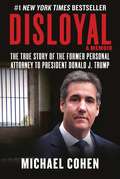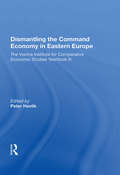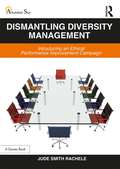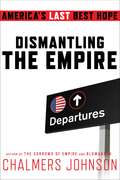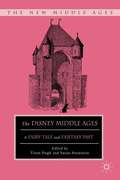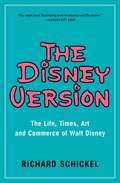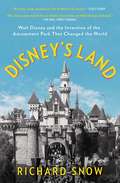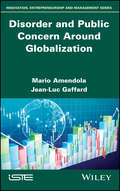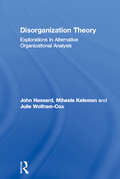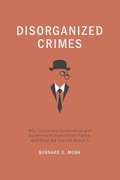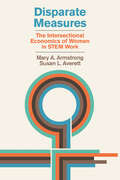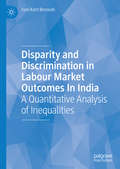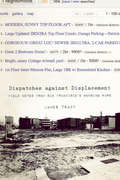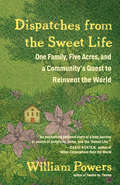- Table View
- List View
Diskussion und Debatte: Wie man in Gremien zu guten Entscheidungen kommt (essentials)
by Hermann MeierIn Gremien, Kommissionen und Versammlungen werden - im Idealfall nach sorgfältiger Erörterung aller Argumente - Entscheidungen erarbeitet, Beschlüsse gefasst und Repräsentanten gewählt. In diesem Buch wird gezeigt, nach welchen Regeln solche Entscheidungsprozesse ablaufen und was dabei zu beachten ist: Wie man Sitzungen vorbereitet und warum das wichtig ist. Wie man als Sitzungsleiter agiert, damit die Sitzung erfolgreich wird. Wie man in Diskussionen Ihre Argumente optimal einbringt. Wie man Manipulation erkennt und ihr begegnet. Also: Wie man in Gremien, Versammlungen und Sitzungen zu guten Entscheidungen kommt.
Disloyal: The True Story of the Former Personal Attorney to President Donald J. Trump
by Michael CohenOnce Donald Trump’s fiercest surrogate, closest confidant, and staunchest defender, Michael Cohen knows where the skeletons are buried. <p><p> This is the most devastating business and political horror story of the century. As Trump’s lawyer and “fixer,” Cohen not only witnessed firsthand but was also an active participant in the inner workings of Trump’s business empire, political campaign, and presidential administration. <p> This is a story that you have not read in newspapers, or on social media, or watched on television. These are accounts that only someone who worked for Trump around the clock for over a decade—not a few months or even a couple of years—could know. Cohen describes Trump’s racist rants against President Barack Obama, Nelson Mandela, and Black and Hispanic people in general, as well as the cruelty, humiliation, and abuse he leveled at family and staff. Whether he’s exposing the fact that Trump engaged in tax fraud by inflating his wealth or electronic fraud by rigging an online survey, or outing Trump’s Neanderthal views towards women or his hush-money payments to clandestine lovers, Cohen pulls no punches. <p> He shows Trump’s relentless willingness to lie, exaggerate, mislead, or manipulate. Trump emerges as a man without a soul—a man who courts evangelicals and then trashes them, panders to the common man, but then rips off small business owners, a con man who will do or say absolutely anything to win, regardless of the cost to his family, his associates, or his country. <p> At the heart of Disloyal, we see how Cohen came under the spell of his charismatic "Boss" and, as a result, lost all sense of his moral compass. <p> The real "real" Donald Trump who permeates these pages—the racist, sexist, homophobic, lying, cheating President—will be discussed, written about, and analyzed for years to come.<p> <b>A New York Times Bestseller</b>
Dismantling The Command Economy In Eastern Europe: The Vienna Institute For Comparative Economic Studies Yearbook Iii
by Peter HavlikThe contributors to this volume analyze the general problems of economic transition in countries of the former Eastern bloc: changing the ownership structure, abolishing the command economy, and integrating with the world economy. Because unique political, economic and social conditions in each nation require individual policy solutions, the contri
Dismantling Diversity Management: Introducing an Ethical Performance Improvement Campaign
by Jude Smith RacheleGlobal diversity and inclusion management practice is in a state of arrested development. Leaders and practitioners are caught in grooves which are no longer effective, if they ever were. In Dismantling Diversity Management, Dr. Jude Smith Rachele takes a big leap in propounding that businesses, given the incredible complexity of the world’s social, economic and political fabric, must embrace morality and not just seek to act merely for reasons of legal compliance or profit. It presents a joined up system of diversity, which also extends beyond human resources into the wider fields of organization and leadership development. The book emphasizes the vital importance of ethical and values-driven leadership and of living, not just spouting out, corporate values. Jude provides a valuable contribution to the international field of diversity management as she highlights the key flaws in traditional diversity management thinking, and presents to the reader a clear picture of the barriers in place which make it difficult for practitioners, leaders and all of those committed to social justice to achieve desired outcomes within organizations. This book is a courageous and refreshing look at diversity. It not only provides a bold critique of how corporate structure has co-opted people into a diversity management model which perpetuates, rather than, transforms the status quo, it also maps out how to break this ineffective cycle. Dismantling Diversity Management will be of interest to organizational development professionals, diversity and inclusion practitioners, senior executive officers and human resource and talent management professionals.
Dismantling the Empire: America's Last Best Hope
by Chalmers JohnsonThe author of the bestselling Blowback Trilogy reflects on America's waning power in a masterful collection of essays. In his prophetic book Blowback, published before 9/11, Chalmers Johnson warned that our secret operations in Iraq and elsewhere around the globe would exact a price at home. Now, in a brilliant series of essays written over the last three years, Johnson measures that price and the resulting dangers America faces. Our reliance on Pentagon economics, a global empire of bases, and war without end is, he declares, nothing short of "a suicide option." Dismantling the Empire explores the subjects for which Johnson is now famous, from the origins of blowback to Barack Obama's Afghanistan conundrum, including our inept spies, our bad behavior in other countries, our ill-fought wars, and our capitulation to a military that has taken ever more control of the federal budget. There is, he proposes, only one way out: President Obama must begin to dismantle the empire before the Pentagon dismantles the American Dream. If we do not learn from the fates of past empires, he suggests, our decline and fall are foreordained. This is Johnson at his best: delivering both a warning and an urgent prescription for a remedy.
Dismissing an Employee
by Harvard Business School PressWhile no one likes to be the bearer of bad news, managers are sometimes faced with the difficult task of having to dismiss an employee. In this book, you'll learn how to effectively manage a dismissal--including making key decisions before, during, and after the critical event. Handled skillfully, dismissing an employee can set your team--and your company--on a positive new path.
Disney Consumer Products: Marketing Nutrition to Children
by Laura Winig David E. BellIn an effort to capture market share in the children's foods category, Disney Consumer Products (DCP) debuted a broad line of "better for you" foods, ranging from fresh fruits and vegetables to frozen meals, through a partnership with Kroger supermarkets. In answer to a global obesity epidemic, DCP reformulated existing products and introduced new ones which met stringent nutritional requirements. Disney--and by extension, DCP--is highly influential with children: can the company use its "magic" to get children to switch from sugary, processed foods and become lifelong converts to a more nutritious diet? What is the food industry's responsibility in this controversial space?
Disney Consumer Products in Lebanon
by John A. QuelchThe managing director of Disney Consumer Products for Europe and the Middle East is reviewing recent market research in Lebanon regarding the sales potential of Disney licensed products and assessing the pros and cons of several distribution options.
Disney High: The Untold Story of the Rise and Fall of Disney Channel's Tween Empire
by Ashley SpencerThe first unauthorized look at the inner workings—and ultimate breakdown—of the Disney Channel machine For many kids growing up in the 2000s, there was no cultural touchstone more powerful than Disney Channel, the most-watched cable channel in primetime at its peak. Today, it might best be known for introducing the world to talents like Hilary Duff, Raven-Symoné, Zac Efron, Miley Cyrus, Selena Gomez, the Jonas Brothers, Demi Lovato, and Zendaya. It wasn't always destined for greatness: when The Disney Channel launched in 1983, it was a forgotten stepchild within the Walt Disney Company, forever in the shadow of Disney’s more profitable movies and theme parks. But after letting the stars of their Mickey Mouse Club revival—among them Britney Spears, Justin Timberlake, Christina Aguilera, and Ryan Gosling—slip through their fingers, Disney Channel reinvented itself as a powerhouse tween network. In the new millennium, it churned out billions of dollars in original content and triple-threat stars whose careers were almost entirely controlled by the corporation. Suddenly, everyone wanted a piece of the pie—and there were constant clashes between the studio, network, labels, and creatives as Disney Channel became a pressure cooker of perfection for its stars. From private feuds and on-set disasters, to fanfare that swept the nation and the realities of child stardom, culture journalist Ashley Spencer offers the inside story of the heyday of TV’s House of Mouse, featuring hundreds of exclusive new interviews with former Disney executives, creatives, and celebrities to explore the highs, lows, and everything in between.
The Disney Middle Ages
by Tison Pugh Susan AronsteinFor many, the middle ages depicted in Walt Disney movies have come to figure as the middle ages, forming the earliest visions of the medieval past for much of the contemporary Western (and increasingly Eastern) imagination. The essayists of The Disney Middle Ages explore Disney's mediation and re-creation of a fairy-tale and fantasy past, not to lament its exploitation of the middle ages for corporate ends, but to examine how and why these medieval visions prove so readily adaptable to themed entertainments many centuries after their creation. What results is a scrupulous and comprehensive examination of the intersection between the products of the Disney Corporation and popular culture's fascination with the middle ages.
The Disney Version: The Life, Times, Art and Commerce of Walt Disney
by Richard Schickel“The single most illuminating work on America and the movies” (The Kansas City Star): the story of how a shy boy from Chicago crashed Hollywood and created the world’s first multimedia entertainment empire—one that shapes American popular culture to this day. When Walter Elias Disney moved to Hollywood in 1923, the twenty-one-year-old cartoonist seemed an unlikely businessman—and yet within less than two decades, he’d transformed his small animation studio into one of the most successful and beloved brands of the twentieth century. But behind Disney’s boisterous entrepreneurial imagination and iconic characters lay regressive cultural attitudes that, as The Walt Disney Company’s influence grew, began to not simply reflect the values of midcentury America but actually shape the country’s character. Lauded as “one of the best studies ever done on American popular culture” (Stephen J. Whitfield, Professor of American Civilization at Brandeis University), Richard Schickel’s The Disney Version explores Walt Disney’s extraordinary entrepreneurial success, his fascinatingly complex character, and—decades after his death—his lasting legacy on America.
The Disney Way: Harnessing the Management Secrets of Disney in Your Company (Third Edition)
by Bill Capodagli Lynn JacksonProfiling a new set of diverse organizations--such as TYRA Beauty, Rainbow Babies & Children's Hospital, Ottawa County, Michigan, and Science Center of Iowa--the authors show how companies of any size, whether an entrepreneurial startup or a Fortune 500, can reach their utmost potential by embracing Walt Disney's techniques to create a consumer-centric culture.
Disney's Land: Walt Disney and the Invention of the Amusement Park That Changed the World
by Richard SnowA propulsive history chronicling the conception and creation of Disneyland, the masterpiece California theme park, as told like never before by popular historian Richard Snow.One day in the early 1950s, Walt Disney stood looking over 240 acres of farmland in Anaheim, California, and imagined building a park where people &“could live among Mickey Mouse and Snow White in a world still powered by steam and fire for a day or a week or (if the visitor is slightly mad) forever.&” Despite his wealth and fame, exactly no one wanted Disney to build such a park. Not his brother Roy, who ran the company&’s finances; not the bankers; and not his wife, Lillian. Amusement parks at that time, such as Coney Island, were a generally despised business, sagging and sordid remnants of bygone days. Disney was told that he would only be heading toward financial ruin. But Walt persevered, initially financing the park against his own life insurance policy and later with sponsorship from ABC and the sale of thousands and thousands of Davy Crockett coonskin caps. Disney assembled a talented team of engineers, architects, artists, animators, landscapers, and even a retired admiral to transform his ideas into a soaring yet soothing wonderland of a park. The catch was that they had only a year and a day in which to build it. On July 17, 1955, Disneyland opened its gates…and the first day was a disaster. Disney was nearly suicidal with grief that he had failed on a grand scale. But the curious masses kept coming, and the rest is entertainment history. Eight hundred million visitors have flocked to the park since then. In Disney&’s Land, Richard Snow brilliantly presents the entire spectacular story, a wild ride from vision to realization, and an epic of innovation and error that reflects the uniqueness of the man determined to build &“the happiest place on earth&” with a watchmaker&’s precision, an artist&’s conviction, and the desperate, high-hearted recklessness of a riverboat gambler.
Disney's "The Lion King" (A): The $2 Billion Movie
by Carin-Isabel Knoop Cate Reavis Jeffrey F. RayportIn 1994, just 10 years after its filmed entertainment division lost $33 million, Disney's animated creation "The Lion King" became the second highest grossing film ever. In addition to drawing $740 million in worldwide box office sales, its merchandise sales exceeded $1.5 billion. This case describes Disney CEO Michael Eisner's strategy in rebuilding the filmed entertainment division, the making of "The Lion King," and the design and execution of a mini-Lion King retail industry. Along with the movie's achievements, Disney was experiencing internal chaos.
DisneyWar: The Battle for the Magic Kingdom
by James B. Stewart"When You Wish Upon a Star," "Whistle While You Work," "The Happiest Place on Earth" -- these are lyrics indelibly linked to Disney, one of the most admired and best-known companies in the world. So when Roy Disney, chairman of Walt Disney Animation and nephew of founder Walt Disney, abruptly resigned in November 2003 and declared war on chairman and chief executive Michael Eisner, he sent shock waves through the entertainment industry, corporate boardrooms, theme parks, and living rooms around the world -- everywhere Disney does business and its products are cherished. DisneyWar is the breathtaking, dramatic inside story of what drove America's best-known entertainment company to civil war, told by one of our most acclaimed writers and reporters. Drawing on unprecedented access to both Eisner and Roy Disney, current and former Disney executives and board members, as well as thousands of pages of never-before-seen letters, memos, transcripts, and other documents, James B. Stewart gets to the bottom of mysteries that have enveloped Disney for years: What really caused the rupture with studio chairman Jeffrey Katzenberg, a man who once regarded Eisner as a father but who became his fiercest rival? How could Eisner have so misjudged Michael Ovitz, a man who was not only "the most powerful man in Hollywood" but also his friend, whom he appointed as Disney president and immediately wanted to fire? What caused the break between Eisner and Pixar chairman Steve Jobs, and why did Pixar abruptly abandon its partnership with Disney? Why did Eisner so mistrust Roy Disney that he assigned Disney company executives to spy on him? How did Eisner control the Disney board for so long, and what really happened in the fateful board meeting in September 2004, when Eisner played his last cards? Here, too, is the creative process that lies at the heart of Disney -- from the making of The Lion King to Pirates of the Caribbean. Even as the executive suite has been engulfed in turmoil, Disney has worked -- and sometimes clashed -- with a glittering array of stars, directors, designers, artists, and producers, many of whom tell their stories here for the first time. Stewart describes how Eisner lost his chairmanship and why he felt obliged to resign as CEO, effective 2006. No other book so thoroughly penetrates the secretive world of the corporate boardroom. DisneyWar is an enthralling tale of one of America's most powerful media and entertainment companies, the people who control it, and those trying to overthrow them. DisneyWar is an epic achievement. It tells a story that -- in its sudden twists, vivid, larger-than-life characters, and thrilling climax -- might itself have been the subject of a Disney animated classic -- except that it's all true.
Disobedient Bodies
by Emma DabiriAn unmissable, radical essay from Emma Dabiri, bestselling author of Don't Touch My Hair and What White People Can Do Next.What part of your beautiful self were you taught to hate? We spend a lot of time trying to improve our 'defects', according to society's ideals of beauty. But these ideals that are often reductive, tyrannical and commercially entangled, imposed upon us by oppressive systems and further strengthened by our conditioned self-loathing.This book encourages unruliness, exploring the ways in which we can rebel against and subvert the current system. Offering alternative ways of seeing beauty, drawing on other cultures, worldviews, times, and places, as well as looking beyond the capitalist model - to reconnect with our birth right and find the inherent joy in our disobedient bodies.It accompanies The Cult of Beauty, a major exhibition at Wellcome Collection in autumn 2023.
Disorder and Public Concern Around Globalization
by Mario Amendola Jean-Luc GaffardDisorder and Public Concern Around Globalization examines the contrast between an idealized vision and a realistic view of globalization. Both are inscribed in the contemporary debate within political and economic theory. This opposition highlights the conditions under which wealth creation and equitable distribution can outweigh the mere diversion of value and deepening of inequalities. This book shows how facts and ideas can explain the shape currently taken by globalization, the latest innovation of market economies. Still, the unpredictable path followed depends on the attitudes of entrepreneurs and capital holders who arbitrate between short- and long-term timescales, between value creation and rent collection: attitudes driven by the same organizations and institutions that shape markets, structure the social order and ensure the viability of the current transition.
Disorder in the Court: Great Fractured Moments in Courtroom History
by Charles M. SevillaIn America's courtooms, the verdict is laughter. Sit back and enjoy a collection of verbatim exchanges from the halls of justice, where defendants and plaintiffs, lawyers and witnesses, juries and judges, collide to produce memorably insane comedy. A: You mumbled on the first part of that and I couldn't understand what you were saying. Could you repeat the question? Q: I mumbled, did I? Well, we'll just ask the court reporter to read back what I said. She didn't indicate any problem understanding what I said, so obviously she understood every word. We'll just have her read my question back and find out if there was any mumbling going on. Madam reporter, would you be so kind? Court Reporter: Mumble, mumble, mumble, mumble, mumble.
Disorganization Theory: Explorations in Alternative Organizational Analysis
by John Hassard Mihaela Kelemen Julie Wolfram CoxOrganizational analysis has moved in a number of directions since its origins in mainstream theories of positivism and functionalism. This challenging book sets out an alternative agenda for the field, discussing existing critical discourses, whilst exploring a selection of emerging ideas and arguments. Addressing a series of key epistemologic
Disorganized Crimes
by Bernard E. MunkCorporate misgovernance and the failure of government regulation have led to major financial fiascos. 'Disorganized crimes' are disruptive and costly. Munk links the two major eras of corporate misgovernance during the last decade to explain how these events occur and what can be done to prevent them from re-occurring.
Disparate Measures: The Intersectional Economics of Women in STEM Work
by Mary A. Armstrong Susan L. AverettAn exploration of workplace participation and earnings patterns for diverse women in US STEM professions that upends the myth that STEM work benefits women economically.Seen as part economic driver, part social remedy, STEM work is commonly understood to benefit both the US economy and people—particularly women—from underrepresented groups. But what do diverse women find when they work in US STEM occupations? What do STEM jobs really deliver—and for whom? In Disparate Measures, Mary Armstrong and Susan Averett challenge the conventional wisdom that a diverse US STEM workforce will bring about economic abundance for the women who participate in it. Combining intersectionality theory and critical data theory with a feminist economic analysis, the authors explore how different groups of diverse women truly fare in US STEM professions.Disparate Measures is centered on eight unique, in-depth case studies, each of which provides an intersectional economic analysis (a term coined by the authors) of diverse women working in STEM occupations. Four case studies prioritize women of color and examine the STEM participation and earnings of Black women, American Indian and Alaska Native women, Asian and Pacific Islander women, and Hispanic women/Latinas; four additional case studies illuminate intersections that are frequently neglected by the STEM inclusivity literature: foreign-born women, women with disabilities, Queer women, and mothers. What the authors find in their groundbreaking, detailed analysis is that the promises of STEM are only partly true: when compared to women not working in STEM, most women are indeed economically elevated by STEM occupations—yet when compared to white men in the same STEM occupations, women&’s second-class status is usually reaffirmed. The authors conclude by offering seven &“big-picture&” recommendations for rethinking STEM equity, showing just how we can successfully confront the entrenched patterns of economic disadvantage faced by diverse women in STEM jobs.
Disparity and Discrimination in Labour Market Outcomes in India: A Quantitative Analysis of Inequalities
by Vani Kant Borooah“The author has done a service to this line of study by collating and analysing a novel dataset in a manner that is going to be of use for researchers of the labour market in India, a subject in need of critical enquiry.”– Shanti Chakravarty, Professor of Economics, Bangor University, Wales, UKThis book deconstructs the dynamics of the job market in an emerging economy (India) that has vast capital resources, addressing a key concern in relation to inequality in the labour market by social groups. The author examines the changing impact of caste on employment opportunity using two sets of large databases, and extends this analysis into religious affiliation and gender. The findings in this book will be of importance to those working in both research and policy, and makes an important contribution through addressing the decomposition of inequality based on disparity and discrimination.
Dispatches Against Displacement
by James TracySan Francisco is being eroded by waves of cash flowing north from Silicon Valley. Recent evictions of long-time San Francisco residents, outrageous rents and home prices, and blockaded "Google buses" are only the tip of the iceberg. James Tracy's book focuses on the long arc of displacement over almost two decades of "dot com" boom and bust, offering the necessary perspective to analyze the latest urban horrors.A housing activist in the Bay Area since before Google existed, Tracy puts the hardships of the working poor and middle class front and center. These essays explore the battle for urban space--public housing residents fighting austerity, militant housing takeovers, the vagaries of federal and state housing policy, as well as showdowns against gentrification in the Mission District. From these experiences, Dispatches Against Displacement draws out a vision of what alternative urbanism might look like if our cities were developed by and for the people who bring them to life.James Tracy is a Bay Area native and a well-respected community organizer. He is co-founder of the San Francisco Community Land Trust (which uses public and private money to buy up housing stock and take it out of the real estate market), as well as a poet and co-author of Hillbilly Nationalists, Urban Race Rebels, and Black Power.
Dispatches from the Sweet Life: One Family, Five Acres, and a Community's Quest to Reinvent the World
by William PowersMany fantasize about dramatically changing their lives — living in accordance with their ideals rather than the exigencies of job, bills, and possessions. William Powers actually does it. In his book Twelve by Twelve, Powers lived in an off-grid tiny house in rural North Carolina. In New Slow City, he and his wife, Melissa, inhabited a Manhattan micro-apartment in search of slow in the fastest city in the world. Here, the couple, with baby in tow, search for balance, community, and happiness in a small town in Bolivia. They build an adobe house, plant a prolific orchard and organic garden, and weave their life into a community of permaculturists, bio-builders, artists, and creative businesspeople. Can this Transition Town succeed in the face of encroaching North American capitalism, and can Powers and the other settlers find the balance they’re seeking? Dispatches from the Sweet Life is compelling, sobering, thought-provoking, and, no matter the outcome, inspiring.
Dispensing Beauty in New York & Beyond: The Triumphs and Tragedies of Harriet Hubbard Ayer
by Annette Blaugrund“An excellently researched mixture of history and biography about a maverick Victorian woman who made beauty her business.” —Barbara Goldsmith, New York Times-bestselling author Harriet Hubbard Ayer moved to New York City by 1883 and established Recamier Preparations, Inc., the earliest cosmetic company owned and operated by a woman. First with her creams and balms and then with her words about women’s health and beauty, she influenced several generations of women to look and feel good about themselves. The jealous and vindictive men in her life punished her for her ambition, accomplishments and independence by attempting to steal her lucrative business and seize her children. After she successfully sued them, they had her committed to an insane asylum. Indomitable, this former Chicago socialite reinvented herself as the highest paid newspaperwoman in the United States, editing the women’s pages of Joseph Pulitzer’s New York World. Her incredible story is presented here as never before.“Ayer emerges from Dr. Blaugrund’s portrait as an innovative entrepreneur, crack reporter, and pioneer of the American feminist movement.” —Sidney Offit, author, teacher, curator emeritus of the George Polk Journalism Award of the Author’s Guild “Just when we thought there were no more original American characters, along comes Annette Blaugrund’s fine biography of the little-known feminist pioneer Harriet Hubbard Ayer—her harrowing struggles, her inspiring achievements, her unexpected triumphs. What a marvelous tale written in a riveting manner!”—William A. Johnson, professor emeritus of philosophy, Brandeis University

